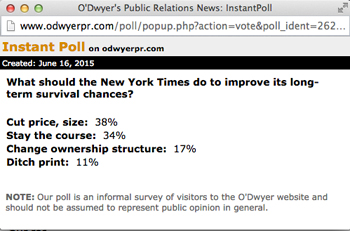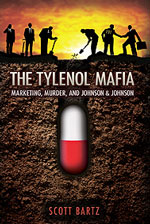NYT's Arthur Sulzberger took the stage at Hunter College June 15 to boast about the paper's survival in the Digital Age and to take advice from the audience. Our readers say cut the size and consider an ownership change.
Nine days of voting in the odwyerpr.com poll resulted in 38% of participants saying the Times should "cut the price and size" of the paper; 34% said, "Stay the course," 18% said "Change ownership," and 10% said "Ditch print."
 O'Dwyer readers watch the NYT as closely as anything can be watched and their opinions should be taken seriously by the paper.
O'Dwyer readers watch the NYT as closely as anything can be watched and their opinions should be taken seriously by the paper.
Stories that take forever to get to the news are driving readers from the paper, wrote Michael Kinsley.
The lavish use of color pictures and art, while eye candy, is something the paper cannot afford. It lost $14.3M in Q1 partly because of a $42.3M pension charge for payments to nearly 100 employees who were offered retirement packages.
If it wants to be modern, the paper should start putting tinyurl-type links in print stories that provide easy access to previous stories, documents, and databases. Reporter bylines should also show their emails which is standard practice at the New York Post, Newsday and many other papers. NYT writers are too aloof.
The Sulzberger session, which included executive editor Dean Baquet, was a good start but regular such programs are needed. Flaws of the program were that no photographs by press were allowed and none of the questioners were shown on camera during the half hour of audience participation. Reporters were not among those asking questions, which were mild. One speaker complained about the ditching of the bridge and chess columns.
Ownership Change Is Needed
 Sulzberger SulzbergerPhoto: Sharlene Spingler |
Sulzberger is proud that family ownership of the paper is heading into the fifth generation. That is a negative in our view, not a positive. A news medium of the importance of NYT should not be under the control of one family which is identified with certain causes and cultures.
Urging an "ownership change" were 18% of O'Dwyer respondents, the third highest vote after "cut price/size" (38%) and "stay the course" (34%).
Sulzberger told the Hunter audience that the paper "gets things right" even though it may be second or even fourth on stories.
We can point to at least five important stories that the paper is not covering because of politics, religion, or other factors.
Hamptons' Eruv Dispute Avoided
 It is not covering the multi-million eruv dispute in Southampton, Westhampton and Quogue; the highly publicized ouster of Rabbi Schneier from the Hampton Synagogue by the American Rabbinical Council; The Tylenol Mafia, 500-page book by Scott Bartz that had evidence the 1982 poisonings of seven people in Chicago took place while the Tylenols were in the control of J&J; the victory of the O'Dwyer Co. in 1995 in a copyright lawsuit that was the top story of the New York Law Journal, and the rape accusations against three students of Florida Int'l University in 2011 that drew thousands of words in other media. Oddly, NYT expended tens of thousands of words on three Duke students accused of rape in 2006.
It is not covering the multi-million eruv dispute in Southampton, Westhampton and Quogue; the highly publicized ouster of Rabbi Schneier from the Hampton Synagogue by the American Rabbinical Council; The Tylenol Mafia, 500-page book by Scott Bartz that had evidence the 1982 poisonings of seven people in Chicago took place while the Tylenols were in the control of J&J; the victory of the O'Dwyer Co. in 1995 in a copyright lawsuit that was the top story of the New York Law Journal, and the rape accusations against three students of Florida Int'l University in 2011 that drew thousands of words in other media. Oddly, NYT expended tens of thousands of words on three Duke students accused of rape in 2006.
NYT only provided two AP short stories on Garrett Wittels, one of the three FIU students accused of rape at the Atlantis Resort in the Bahamas, who was perhaps the most famous college athlete in the U.S. that year, boasting a 54-game hitting streak in baseball.
The initial story on this, in the Dec. 27 Broward Palm Beach News, headlined "Deeply Religious FIU Baseball Star Arrested on Rape Charges." It noted Wittels recited a Jewish prayer while kneeling in the outfield before each game.
NYT was fascinated by Wittels until the alleged rape incident. Reporter Karen Crouse wrote 1,096 words about the baseball player and his streak on June 2, 2010, saying he was a "ray of sunshine" for FIU after the murder of football player Kendall Berry on campus March 25. "Because of Wittels, the country is seeing FIU baseball in a positive light," wrote Crouse. Headline was "Hitting Streak Lifts Shadows Over a Campus."


 Trump Media & Technology Group today reported a $58.2M net loss on $4.1M in 2023 revenues, a disclosure that drove its stock price down 22.6 percent to $47.96.
Trump Media & Technology Group today reported a $58.2M net loss on $4.1M in 2023 revenues, a disclosure that drove its stock price down 22.6 percent to $47.96. Barry Pollack, an attorney at Wall Street’s Harris St. Laurent & Wechsler, has registered Julian Assange as a client with the Justice Dept. “out of an abundance of caution.”
Barry Pollack, an attorney at Wall Street’s Harris St. Laurent & Wechsler, has registered Julian Assange as a client with the Justice Dept. “out of an abundance of caution.” Paramount Global to slash 800 jobs in what chief executive Bob Bakish calls part of an effort to “return the company to earnings growth"... Rolling Stone editor-in-chief Noah Shachtman is exiting at the end of the month due to disagreements with chief executive Gus Wenner over the direction the magazine is taking... The New York Times broke the $1 billion barrier in annual revenue from digital subscriptions in 2023... Press Forward is investing more than $500 million to strengthen local newsrooms.
Paramount Global to slash 800 jobs in what chief executive Bob Bakish calls part of an effort to “return the company to earnings growth"... Rolling Stone editor-in-chief Noah Shachtman is exiting at the end of the month due to disagreements with chief executive Gus Wenner over the direction the magazine is taking... The New York Times broke the $1 billion barrier in annual revenue from digital subscriptions in 2023... Press Forward is investing more than $500 million to strengthen local newsrooms. The majority of news articles are read within the first three days of publication, according to a recent report.
The majority of news articles are read within the first three days of publication, according to a recent report. The Los Angeles Times gives pink slips to 115 people or 20 percent of its newsroom staff... TIME is also laying off about 30 employees, which is approximately 15 percent of its editorial staff... The Baltimore Banner, which was launched by Stewart Bainum in 2022 after he failed to buy the Baltimore Sun, added 500 subscribers per day in the three days following Sinclair Broadcast Group's deal to purchase the Sun.
The Los Angeles Times gives pink slips to 115 people or 20 percent of its newsroom staff... TIME is also laying off about 30 employees, which is approximately 15 percent of its editorial staff... The Baltimore Banner, which was launched by Stewart Bainum in 2022 after he failed to buy the Baltimore Sun, added 500 subscribers per day in the three days following Sinclair Broadcast Group's deal to purchase the Sun.


 Have a comment? Send it to
Have a comment? Send it to 
No comments have been submitted for this story yet.